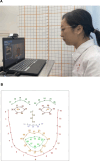Video tracking-based mandibular movement kinematic analysis in patients with nasopharyngeal carcinoma
- PMID: 40474310
- PMCID: PMC12139148
- DOI: 10.1186/s40001-025-02715-z
Video tracking-based mandibular movement kinematic analysis in patients with nasopharyngeal carcinoma
Abstract
Objective: Patients with dysphagia due to nasopharyngeal carcinoma (NPC) after radiotherapy often have chewing difficulty. Kinematic analysis of mandibular movements may provide clinically useful information for the chewing function. However, current kinematic device costs limited clinical application, and specialized software is required for control and data processing. This study aimed to mandibular kinematics parameter recognition using a self-developed Nswallow 2D motion capture software. To investigate whether differences in kinematic data of mandibular movements during mastication can be used as an indicator of masticatory dysfunction in NPC patients, and to examine relationship with mastication efficiency.
Method: Thirty-three patients with early-stage NPC after radiotherapy and thirty-seven healthy controls were recruited. The self-developed Nswallow 2D motion capture software was used to automatically mark and capture the facial parts of the participants. We tracked jaw kinematic during chewing and analyzed the characteristics of kinematic data of mandibular movements during chewing tasks. Meanwhile, the masticatory efficiency using two-color chewing gum was analyzed by the ViewGum software.
Result: Significant differences were observed in the mastication time [ Total Masticatory Time (NPC 13.500 (11.600, 16.400); HC 10.533 (9.716, 12.250) & Chewing Sequence Duration (NPC 0.614 (0.582, 0.701); HC 0.544 (0.480, 0.586)], speed of mandibular motion [Maximum Chewing Speed (NPC 23.740 (17.775, 25.906); HC 28.467 (24.009, 38.600) & Average Chewing Speed (NPC 11.844 (10.395,13.285); HC 18.169 (16.586, 19.632)], and Mandibular Motion Amplitude [NPC 7.159 (5.887, 7.869); HC 9.184 (7.541;11.141)] between two groups (P < 0.000). Logistic regression analysis and receiver operating characteristic curve analyses were performed based on the above data as explanatory variables. Among them, the Average Chewing Speed exhibited the highest area under the ROC curve, the odds ratio was 3.629, and the cutoff value was 14.28, with a sensitivity of 90.91%, a specificity of 80.00%, and an area under the curve of 0.9255. The masticatory efficiency in the NPC group significantly decreased compared to the healthy control group (P < 0.000). Linear regression analysis showed that Average Chewing Speed negatively affects masticatory efficiency.
Conclusion: The Nswallow 2D motion capture software represents an easy-to-use and affordable system that can be utilized to assess masticatory function in patients with NPC. The Average Chewing Speed of chewing is a highly sensitive kinematic indicator for evaluating mastication efficiency. Furthermore, the Average Chewing Speed could serve as a screening test for patients with mastication disorder of nasopharyngeal cancer and provide dietary guidance for such individuals.
Keywords: Dysphagia; Kinematics; Mastication; Mastication efficiency; Nasopharyngeal carcinoma.
© 2025. The Author(s).
Conflict of interest statement
Declarations. Ethics approval and consent to participate: This study was approved by the Third Affiliated Hospital of Sun Yat-sen University ([2021]02-200-01) and was conducted according to the principles of the Declaration of Helsinki. Written informed consent was obtained from all participants. Consent for publication: All subjects and/or their legal guardian(s) have given informed consent for their identifying information/images to be published in online open-access publications. Competing interests: The authors declare no competing interests.
Figures



Similar articles
-
Kinematic Features of Mandibular Movement during Mastication in Geriatric Individuals Who Are Provided with a Dysphagia Diet at Long-Term Care Facilities.Nutrients. 2023 May 11;15(10):2273. doi: 10.3390/nu15102273. Nutrients. 2023. PMID: 37242156 Free PMC article.
-
Markerless three-dimensional tracking of masticatory movement.J Biomech. 2016 Feb 8;49(3):442-9. doi: 10.1016/j.jbiomech.2016.01.011. Epub 2016 Jan 21. J Biomech. 2016. PMID: 26827172
-
Study of the kinematic variables of unilateral and habitual mastication of healthy individuals.Codas. 2017 Mar 30;29(2):e20160074. doi: 10.1590/2317-1782/20172016074. Codas. 2017. PMID: 28380201 English, Portuguese.
-
Correlation of mastication and masticatory movements and effect of chewing side preference.Braz Dent J. 2010;21(4):351-5. doi: 10.1590/s0103-64402010000400011. Braz Dent J. 2010. PMID: 20976387
-
Reproducibility of 3D kinematics and surface electromyography measurements of mastication.Physiol Behav. 2016 Mar 1;155:112-21. doi: 10.1016/j.physbeh.2015.11.018. Epub 2015 Nov 23. Physiol Behav. 2016. PMID: 26617403
References
-
- De Toledo IP, Pantoja LLQ, Luchesi KF, Assad DX, De Luca CG, Guerra ENS. Deglutition disorders as a consequence of head and neck cancer therapies: a systematic review and meta-analysis. Support Care Cancer. 2019;27(10):3681–700. - PubMed
-
- Vissink A, Jansma J, Spijkervet FK, Burlage FR, Coppes RP. Oral sequelae of head and neck radiotherapy. Crit Rev Oral Biol Med. 2003;14(3):199–212. - PubMed
MeSH terms
Grants and funding
LinkOut - more resources
Full Text Sources

